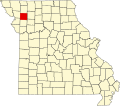DeKalb County, Missouri | |
|---|---|
 DeKalb County Courthouse in Maysville | |
 Location within the U.S. state of Missouri | |
 Missouri's location within the U.S. | |
| Coordinates: 39°54′N94°24′W / 39.9°N 94.4°W | |
| Country | |
| State | |
| Founded | February 25, 1845 |
| Named after | Johann de Kalb |
| Seat | Maysville |
| Largest city | Cameron |
| Area | |
• Total | 426 sq mi (1,100 km2) |
| • Land | 421 sq mi (1,090 km2) |
| • Water | 4.5 sq mi (12 km2) 1.0% |
| Population (2020) | |
• Total | 11,029 |
• Estimate (2023) | 9,899 |
| • Density | 26.2/sq mi (10.1/km2) |
| Time zone | UTC−6 (Central) |
| • Summer (DST) | UTC−5 (CDT) |
| Congressional district | 6th |
| Website | www |
DeKalb County is a county located in the northwest portion of the U.S. state of Missouri. As of the 2020 census, the population was 11,029. [1] Its county seat is Maysville. [2] The county was organized February 25, 1845 [3] and named for General Johann de Kalb, [4] Baron de Kalb, of the Revolutionary War. DeKalb County is part of the St. Joseph, MO-KS Metropolitan Statistical Area, which is also included in the Kansas City-Overland Park-Kansas City, MO-KS Combined Statistical Area.
Contents
- Geography
- Adjacent counties
- Major highways
- Transit
- Demographics
- 2020 census
- 2000 census
- Religion
- Education
- Public Schools
- Public libraries
- Communities
- Cities
- Villages
- Unincorporated Community
- Extinct Places
- Politics
- Local
- State
- Federal
- Missouri presidential preference primaries
- See also
- References
- External links
